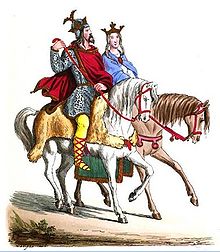Judith of Flanders
| Judith of Flanders | |
|---|---|

A nineteenth-century depiction of Judith and her third husband Baldwin.
|
|
| Queen consort of Wessex | |
| Tenure | 1 October 856 – 13 January 858 (1st Time) 858 – 20 December 860 (2nd Time) |
| Countess of Flanders | |
| Tenure | 13 December 862 – c. 870 |
| Born | c. 843 |
| Died | after 870 |
| Spouse |
Æthelwulf, King of Wessex (m. 856 – wid. 858) Æthelbald, King of Wessex (m. 858 – wid. 860) Baldwin I of Flanders (m. 861/62) |
| Issue |
Baldwin II Charles Raoul |
| House |
Carolingian dynasty (by birth) House of Wessex (by marriage) |
| Father | Charles the Bald |
| Mother | Ermentrude of Orléans |
Judith of Flanders (or Judith of France) (c. 843 – c. 870) was queen consort of Wessex and countess consort of Flanders. She was the eldest daughter of the West Frankish King and later Holy Roman Emperor Charles the Bald and his wife Ermentrude of Orléans. Through her marriages to two Kings of Wessex, Æthelwulf and Æthelbald, she was twice a queen. Her first two marriages were childless, but through her third marriage to Baldwin, she became the first Countess of Flanders and an ancestor of later Counts of Flanders. One of her sons by Baldwin married Ælfthryth, a daughter of Æthelbald's brother, Alfred the Great. She was also an ancestor of Matilda of Flanders, the consort of William the Conqueror, and thus of later monarchs of England.
In 855 King Æthelwulf of Wessex made a pilgrimage to Rome, and on his way back in 856 he stayed at the court of the West Frankish king Charles the Bald. In July Æthelwulf became engaged to Charles's daughter, Judith, who was no more than fourteen, while Æthelwulf was about fifty years old. On 1 October 856 they were married at Verberie in northern France.
The marriage was a diplomatic alliance: both men were suffering from Viking attacks, and for Æthelwulf the union had the advantage of associating him with Carolingian prestige. In addition, the wedding was considered an extraordinary event by contemporaries and by modern historians. Carolingian princesses rarely married and were usually sent to nunneries, and it was almost unknown for them to marry foreigners. Judith was crowned queen and anointed by Hincmar, Archbishop of Rheims; in Wessex it was not customary for kings' wives to be queens, but Charles insisted that his daughter be crowned queen. Although empresses had been anointed before, this is the first definitely known anointing of a Carolingian queen. In addition, West Saxon custom (described by Asser as "perverse and detestable") was that the wife of a king of Wessex could not be called queen or sit on the throne with her husband—she was merely the king's wife.
...
Wikipedia
